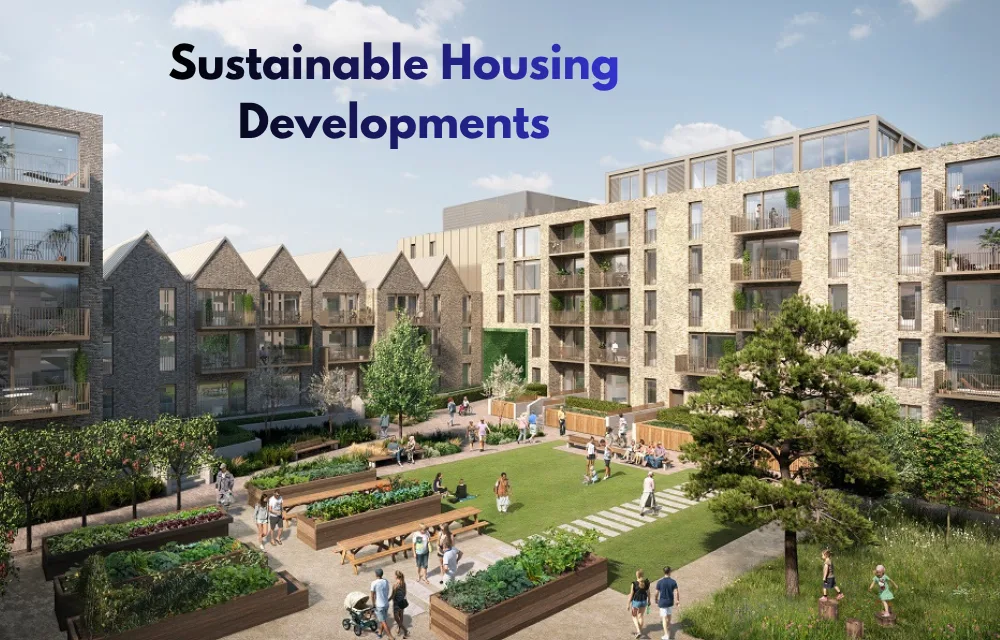Sustainable Housing Developments
Read latest blogs and articles from Housystan

The Information mentioned here was last updated on:
4/12/2025Sustainable Housing Developments: Building a Greener Future for Communities
As cities grow and populations rise, the demand for homes that are both affordable and environmentally friendly has become more urgent than ever. Sustainable housing developments aim to strike a balance between human comfort and the planet’s well-being, offering long-term solutions to environmental challenges like climate change, resource depletion, and waste generation.
At the heart of a truly sustainable home is a concept often called "passive design." This simply means the house is designed to use natural elements like the sun and the breeze to keep it comfortable. Think of it as a low-tech, genius way of heating and cooling.
- Verified Tenants/Buyers
- Unlimited Property Listing
- Zero subscription/charges fee
Understanding Sustainable Housing
Sustainable housing refers to homes that are designed, built, and maintained to reduce their impact on the environment. This involves using energy-efficient materials, renewable energy sources, water-saving systems, and environmentally conscious construction practices. But sustainability isn’t just about green technology it’s also about creating healthier living spaces and stronger communities.
At its core, a sustainable home is one that conserves resources, minimizes waste, and provides a comfortable environment for its occupants. From solar panels on rooftops to proper insulation that reduces heating and cooling needs, every element of a sustainable home is designed with the planet in mind.
The construction sector is one of the largest contributors to global carbon emissions. According to the United Nations Environment Programme, buildings and construction account for nearly 40% of global energy-related CO₂ emissions. This staggering figure highlights why sustainable housing is no longer optional it’s a necessity.
Developers and governments around the world are now investing heavily in green housing initiatives. These projects not only help reduce environmental impact but also offer economic and social benefits. Energy-efficient homes, for instance, can significantly lower electricity and water bills for homeowners. Moreover, communities built on sustainable principles often experience better air quality, reduced noise pollution, and improved overall health among residents.
Energy-efficient homes use less power to maintain comfortable temperatures and run household appliances. This is achieved through smart design choices such as proper insulation, double-glazed windows, LED lighting, and the use of renewable energy systems like solar or wind power. Some sustainable developments even incorporate smart home technology that helps residents monitor and manage their energy usage in real time.
Traditional construction materials like concrete and steel have a high carbon footprint. Sustainable housing developments use greener alternatives such as recycled wood, bamboo, or locally sourced materials that reduce transportation emissions. Builders also use non-toxic paints and finishes to improve indoor air quality.
Water scarcity is a growing concern in many parts of the world. Sustainable homes often include systems for rainwater harvesting, greywater recycling, and low-flow fixtures. These measures help minimize water wastage and ensure that residents have access to clean water without putting extra pressure on local resources.
Sustainability extends beyond individual homes. Well-planned sustainable communities include green spaces, pedestrian-friendly pathways, and access to public transportation. This reduces the need for personal vehicles, cutting down on emissions and promoting healthier lifestyles. Mixed-use developments where residential areas are integrated with shops, schools, and workplaces encourage walkability and reduce commuting time.
Sustainable housing isn’t just good for the planet it’s also good for people and communities. One of the most significant benefits is cost savings. Although green technologies can be more expensive upfront, they lead to substantial savings over time through reduced energy and maintenance costs.
Furthermore, sustainable developments often foster a strong sense of community. Shared green spaces, community gardens, and local renewable energy projects bring residents together, encouraging cooperation and environmental awareness. Health benefits are another major advantage better air quality, natural lighting, and eco-friendly materials contribute to improved physical and mental well-being.
Governments and private sectors are recognizing this potential, introducing policies and incentives to promote eco-friendly housing projects. Tax rebates, green mortgages, and grants for installing renewable energy systems are becoming more common in many countries.
Despite its many benefits, the widespread adoption of sustainable housing still faces several challenges. One major hurdle is the higher initial cost of green materials and technologies. While these costs are offset over time through savings, many developers and homeowners remain hesitant due to budget constraints.
Another challenge is the lack of awareness and expertise. In many regions, builders and architects are still unfamiliar with sustainable design principles, making it harder to implement such practices effectively. Additionally, regulations and building codes in some countries have not yet caught up with sustainability standards, slowing down progress.
There’s also a cultural aspect to consider. Many people still associate sustainable housing with minimalism or alternative lifestyles, rather than seeing it as a mainstream option. Changing these perceptions requires education and awareness campaigns that highlight the comfort, beauty, and practicality of eco-friendly homes.
Moreover, the integration of sustainability into urban design is expanding beyond individual homes. Entire neighborhoods and cities are being built around renewable energy systems, sustainable transport, and circular economies that reuse and recycle resources. Governments, private developers, and communities are beginning to realize that investing in sustainable housing is not just an environmental choice it’s a pathway to long-term resilience and prosperity.
The demand for sustainable housing developments will only continue to grow as people seek better living environments that align with their values and the planet’s needs. By embracing innovation, collaboration, and conscious design, the housing sector has the power to transform the way we live creating homes that nurture both people and the Earth for generations to come.